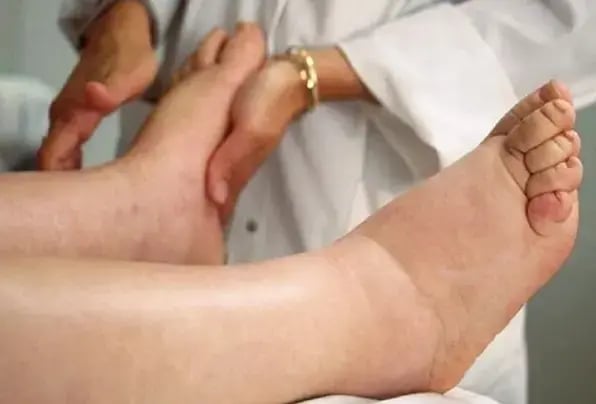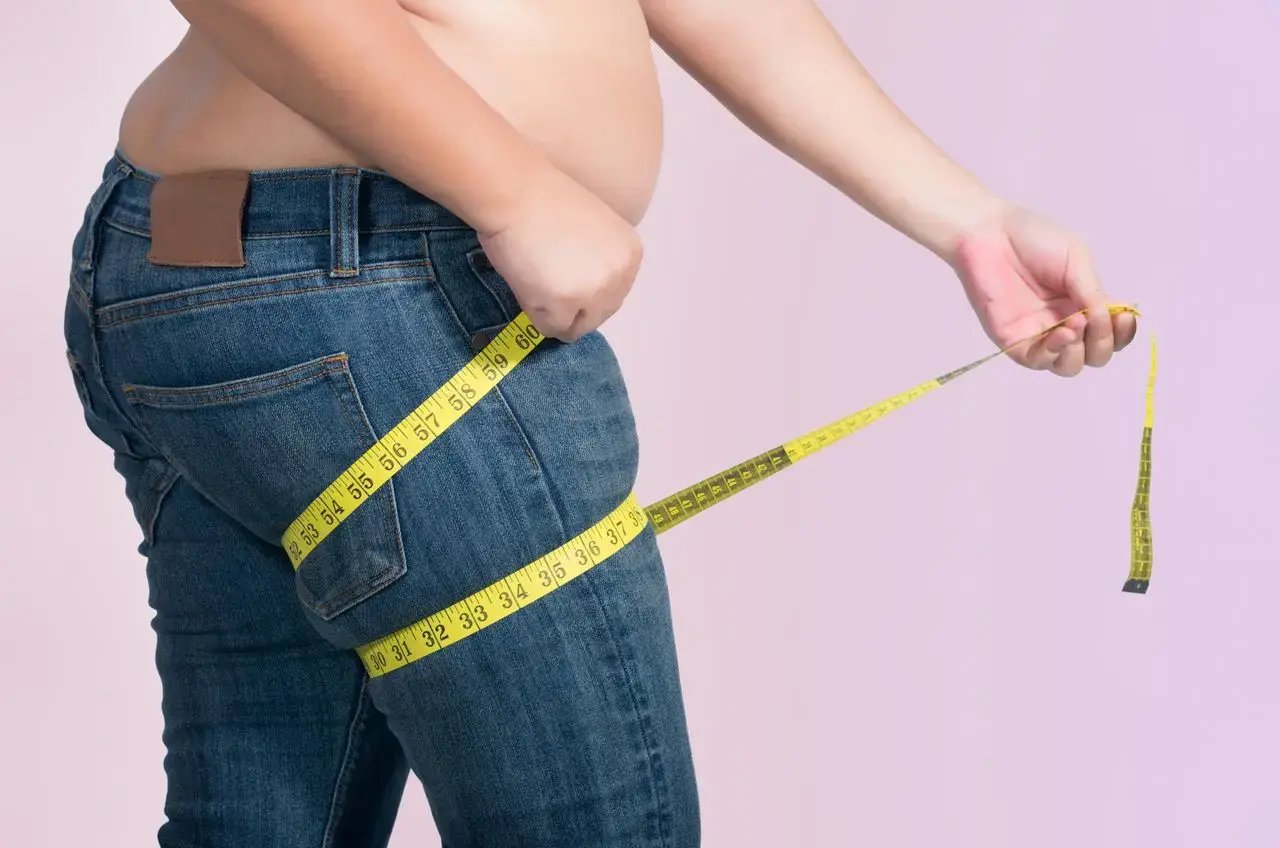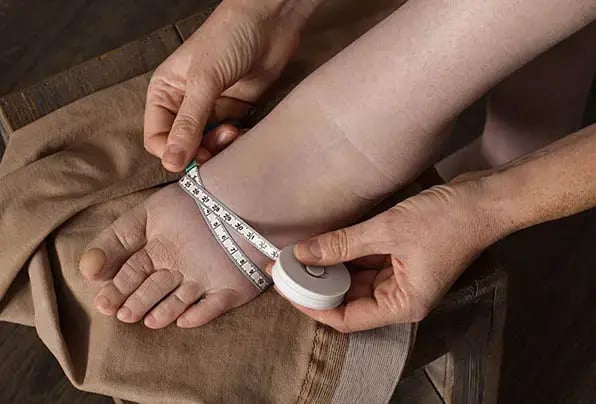Lipedema vs. Lymphedema: What's the Difference?
Lipedema and Lymphedema: Understanding the Key Differences
There is a lot of confusion about lipedema and lymphedema because both cause swelling in the legs. However, the reasons for the swelling are different.
.webp?width=596&height=404&name=lipedema%20(1).webp)
What is the Difference Between Lipedema and Lymphedema?
What’s the Main Difference Between Lipedema and Lymphedema?
Lipedema happens when fat builds up in the legs and sometimes the arms. This swelling doesn’t leave a dimple when you press the skin. On the other hand, lymphedema is caused by poor lymphatic drainage, often due to problems with the lymph nodes. In lymphedema, the skin does leave a dimple when pressed.
Lipedema does not affect the hands and feet, but lymphedema does. People with lymphedema often have skin infections, which is rare in those with lipedema.
What is Lipedema?
What is Lymphedema?
Lymphedema is swelling caused by a buildup of lymph, a fluid rich in protein. Normally, the lymphatic system drains this fluid from the body. Lymphedema most often occurs in the arms or legs and is common in cancer patients because treatments can damage the lymph nodes. Lymphedema can make it hard to move and increase the risk of infections and other serious issues.
Lipedema and lymphedema both cause swelling in the legs but for different reasons. Lipedema is due to excess fat buildup, while lymphedema is caused by poor lymphatic drainage. Lipedema does not affect the hands and feet, but lymphedema does and often leads to skin infections. Understanding these differences can help in getting the right treatment.

Lipedema vs. Lymphedema: Let’s Compare
Lipedema vs. Lymphedema: Causes
Lipedema: The exact cause of lipedema is still unclear. It happens because of too much fat building up under the skin, but this isn't because of obesity or a poor diet. Some research suggests that there may be a link between lipedema and lymphedema, as they share some biomarkers.
We still have many questions about how lipedema develops and its exact mechanisms. We don’t fully understand if it is a lymphatic disease or what causes the pain in lipedema.
Lymphedema: We know more about lymphedema and its causes. It happens when the lymphatic system can't drain lymph fluid properly. This is often due to damage to the lymph nodes. This damage can be caused by cancer cells blocking lymph vessels, radiation treatment for cancer that scars or inflames the lymph nodes, removal of lymph nodes during surgery, or infections from certain parasites.
Lipedema and lymphedema both cause swelling but have different root causes. Lipedema is due to abnormal fat buildup, and the exact cause is not well understood. Lymphedema is caused by poor lymphatic drainage due to damaged lymph nodes, which can result from cancer treatments or infections. Understanding these differences helps in diagnosing and treating these conditions.
Our mission is to create a world where every investment in modern beauty is Worth It.
Let's keep in touch
Get updates of the treatments you are interested
Lipedema vs. Lymphedema: Symptoms
Lipedema: Lipedema mostly affects women, often after hormonal changes like pregnancy or menopause. The legs start to look bigger compared to a smaller waist and upper body. The feet are usually not swollen. If the arms are affected, the hands are not swollen either. The skin might feel soft and cool and have an "orange peel" texture.
Lymphedema: Lymphedema also causes swelling in the arms and legs. Unlike lipedema, lymphedema also affects the fingers and toes. The swelling can make it hard to move, or walk, and can be very painful. The skin can become hard and thick. People with lymphedema often get cellulitis, a serious skin infection. Signs of cellulitis include tenderness, redness, pain, and warmth in the swollen areas. It’s important to watch for these symptoms.
The symptoms of both conditions can vary from person to person. In cases of lymphedema caused by cancer treatment, symptoms might not show up until months or years later.
Lipedema vs. Lymphedema: Fat Distribution
Lipedema: In lipedema, fat builds up mostly on the legs, making the bottom and thighs look much larger than the rest of the body. In severe cases, the fat can spread to the lower legs and sometimes the arms. The hands and feet are usually not affected.
Lymphedema: In lymphedema, swelling happens in parts or all of the arms or legs, including the fingers and toes. The swelling is caused by a buildup of lymphatic fluid, not fat.
Compression stockings can help support heavy legs and reduce swelling.

Lipedema vs. Lymphedema: Causes and Risk Factors
Lipedema: The exact cause of lipedema is unknown. It is often wrongly linked to obesity, but even people with a healthy lifestyle can develop lipedema. The most common triggers are hormonal changes in women, like puberty, pregnancy, menopause, or reactions to hormonal contraception.
Lymphedema: Lymphedema is caused by issues with the lymphatic system. Common causes include:
- Cancer cells blocking lymph vessels
- Cancer treatments, especially radiation, damage lymph nodes
- Surgery that removes lymph nodes
- Infections from certain parasites in tropical countries, which block lymph nodes
Older people and those who are overweight or obese are more at risk for lymphedema.
Diagnosis
If you notice constant swelling in your arms or legs, you should see a doctor to check for lipedema or lymphedema. Tests you might have include:
- MRI scan
- CT scan
- Ultrasound
If you had cancer treatment recently and have matching symptoms, a doctor might diagnose you with lymphedema without further tests. Diagnosing lipedema might require more tests.
Progression
Lipedema: If left untreated, lipedema can become painful and uncomfortable. Early signs include bigger legs or arms and pain or bruising. As it gets worse, the skin may become uneven and dimpled. In severe cases, it can be hard to walk because the skin folds over and the fat sticks out.
Lymphedema: Lymphedema might start with tingling or a heavy feeling. This can last for years before major symptoms show up. At first, swelling might create small dents in the skin when pressed but no permanent damage. Swelling may go down when you elevate your legs or arms. In later stages, the swelling doesn't go away, the tissue under the skin becomes thick, and the affected area can become very large or misshapen.
Treatment Options and Management Strategies
There is no cure for either lipedema or lymphedema. Lymphedema can increase the risk of skin infections like cellulitis, so antibiotics might be needed if cellulitis symptoms appear.
Exercise can help improve symptoms for both conditions. Swimming, biking, or walking can reduce swelling and increase mobility without putting too much strain on your joints. Lipedema patients may also benefit from an anti-inflammatory and heart-healthy diet. This can slow down the progression of lipedema, but it won't cause fat loss like a typical weight-loss diet because lipedema fat is different.
Both conditions involve painful swelling. Wearing compression socks, stockings, or tights can help manage this swelling. Compression helps with lymphatic drainage for lymphedema sufferers and provides support for the legs, making exercise less painful.
Some lymphedema patients can use pneumatic compression, which involves wearing an inflatable sleeve that applies pressure to move lymphatic fluid.
Invasive therapies might also help. For lipedema, liposuction can remove fat deposits. For lymphedema, doctors might suggest lymph node transplants or surgeries to create new drainage paths. These options should be discussed with your healthcare provider.
Our mission is to create a world where every investment in modern beauty is Worth It.
Let's keep in touch
Get updates of the treatments you are interested
Can Lipedema Turn Into Lymphedema?
Is Lymphedema More Serious Than Lipedema?

Can Lipedema and Lymphedema Be Cured?
There is also no cure for lymphedema. Reducing fluid build-up and encouraging lymphatic flow can help manage symptoms. Wearing graduated compression tights or stockings can support your limbs during movement and exercise, making it easier to stay active and reduce swelling.
Lipedema and Lymphedema: Understanding the Key Differences
There is a lot of confusion about lipedema and lymphedema because both cause swelling in the legs. However, the reasons for the swelling are different.
.webp?width=596&height=404&name=lipedema%20(1).webp)
What is the Difference Between Lipedema and Lymphedema?
What’s the Main Difference Between Lipedema and Lymphedema?
Lipedema happens when fat builds up in the legs and sometimes the arms. This swelling doesn’t leave a dimple when you press the skin. On the other hand, lymphedema is caused by poor lymphatic drainage, often due to problems with the lymph nodes. In lymphedema, the skin does leave a dimple when pressed.
Lipedema does not affect the hands and feet, but lymphedema does. People with lymphedema often have skin infections, which is rare in those with lipedema.
What is Lipedema?
What is Lymphedema?
Lymphedema is swelling caused by a buildup of lymph, a fluid rich in protein. Normally, the lymphatic system drains this fluid from the body. Lymphedema most often occurs in the arms or legs and is common in cancer patients because treatments can damage the lymph nodes. Lymphedema can make it hard to move and increase the risk of infections and other serious issues.
Lipedema and lymphedema both cause swelling in the legs but for different reasons. Lipedema is due to excess fat buildup, while lymphedema is caused by poor lymphatic drainage. Lipedema does not affect the hands and feet, but lymphedema does and often leads to skin infections. Understanding these differences can help in getting the right treatment.

Lipedema vs. Lymphedema: Let’s Compare
Lipedema vs. Lymphedema: Causes
Lipedema: The exact cause of lipedema is still unclear. It happens because of too much fat building up under the skin, but this isn't because of obesity or a poor diet. Some research suggests that there may be a link between lipedema and lymphedema, as they share some biomarkers.
We still have many questions about how lipedema develops and its exact mechanisms. We don’t fully understand if it is a lymphatic disease or what causes the pain in lipedema.
Lymphedema: We know more about lymphedema and its causes. It happens when the lymphatic system can't drain lymph fluid properly. This is often due to damage to the lymph nodes. This damage can be caused by cancer cells blocking lymph vessels, radiation treatment for cancer that scars or inflames the lymph nodes, removal of lymph nodes during surgery, or infections from certain parasites.
Lipedema and lymphedema both cause swelling but have different root causes. Lipedema is due to abnormal fat buildup, and the exact cause is not well understood. Lymphedema is caused by poor lymphatic drainage due to damaged lymph nodes, which can result from cancer treatments or infections. Understanding these differences helps in diagnosing and treating these conditions.
Our mission is to create a world where every investment in modern beauty is Worth It.
Let's keep in touch
Get updates of the treatments you are interested
Lipedema vs. Lymphedema: Symptoms
Lipedema: Lipedema mostly affects women, often after hormonal changes like pregnancy or menopause. The legs start to look bigger compared to a smaller waist and upper body. The feet are usually not swollen. If the arms are affected, the hands are not swollen either. The skin might feel soft and cool and have an "orange peel" texture.
Lymphedema: Lymphedema also causes swelling in the arms and legs. Unlike lipedema, lymphedema also affects the fingers and toes. The swelling can make it hard to move, or walk, and can be very painful. The skin can become hard and thick. People with lymphedema often get cellulitis, a serious skin infection. Signs of cellulitis include tenderness, redness, pain, and warmth in the swollen areas. It’s important to watch for these symptoms.
The symptoms of both conditions can vary from person to person. In cases of lymphedema caused by cancer treatment, symptoms might not show up until months or years later.
Lipedema vs. Lymphedema: Fat Distribution
Lipedema: In lipedema, fat builds up mostly on the legs, making the bottom and thighs look much larger than the rest of the body. In severe cases, the fat can spread to the lower legs and sometimes the arms. The hands and feet are usually not affected.
Lymphedema: In lymphedema, swelling happens in parts or all of the arms or legs, including the fingers and toes. The swelling is caused by a buildup of lymphatic fluid, not fat.
Compression stockings can help support heavy legs and reduce swelling.

Lipedema vs. Lymphedema: Causes and Risk Factors
Lipedema: The exact cause of lipedema is unknown. It is often wrongly linked to obesity, but even people with a healthy lifestyle can develop lipedema. The most common triggers are hormonal changes in women, like puberty, pregnancy, menopause, or reactions to hormonal contraception.
Lymphedema: Lymphedema is caused by issues with the lymphatic system. Common causes include:
- Cancer cells blocking lymph vessels
- Cancer treatments, especially radiation, damage lymph nodes
- Surgery that removes lymph nodes
- Infections from certain parasites in tropical countries, which block lymph nodes
Older people and those who are overweight or obese are more at risk for lymphedema.
Diagnosis
If you notice constant swelling in your arms or legs, you should see a doctor to check for lipedema or lymphedema. Tests you might have include:
- MRI scan
- CT scan
- Ultrasound
If you had cancer treatment recently and have matching symptoms, a doctor might diagnose you with lymphedema without further tests. Diagnosing lipedema might require more tests.
Progression
Lipedema: If left untreated, lipedema can become painful and uncomfortable. Early signs include bigger legs or arms and pain or bruising. As it gets worse, the skin may become uneven and dimpled. In severe cases, it can be hard to walk because the skin folds over and the fat sticks out.
Lymphedema: Lymphedema might start with tingling or a heavy feeling. This can last for years before major symptoms show up. At first, swelling might create small dents in the skin when pressed but no permanent damage. Swelling may go down when you elevate your legs or arms. In later stages, the swelling doesn't go away, the tissue under the skin becomes thick, and the affected area can become very large or misshapen.
Treatment Options and Management Strategies
There is no cure for either lipedema or lymphedema. Lymphedema can increase the risk of skin infections like cellulitis, so antibiotics might be needed if cellulitis symptoms appear.
Exercise can help improve symptoms for both conditions. Swimming, biking, or walking can reduce swelling and increase mobility without putting too much strain on your joints. Lipedema patients may also benefit from an anti-inflammatory and heart-healthy diet. This can slow down the progression of lipedema, but it won't cause fat loss like a typical weight-loss diet because lipedema fat is different.
Both conditions involve painful swelling. Wearing compression socks, stockings, or tights can help manage this swelling. Compression helps with lymphatic drainage for lymphedema sufferers and provides support for the legs, making exercise less painful.
Some lymphedema patients can use pneumatic compression, which involves wearing an inflatable sleeve that applies pressure to move lymphatic fluid.
Invasive therapies might also help. For lipedema, liposuction can remove fat deposits. For lymphedema, doctors might suggest lymph node transplants or surgeries to create new drainage paths. These options should be discussed with your healthcare provider.
Our mission is to create a world where every investment in modern beauty is Worth It.
Let's keep in touch
Get updates of the treatments you are interested
Can Lipedema Turn Into Lymphedema?
Is Lymphedema More Serious Than Lipedema?

Can Lipedema and Lymphedema Be Cured?
There is also no cure for lymphedema. Reducing fluid build-up and encouraging lymphatic flow can help manage symptoms. Wearing graduated compression tights or stockings can support your limbs during movement and exercise, making it easier to stay active and reduce swelling.







